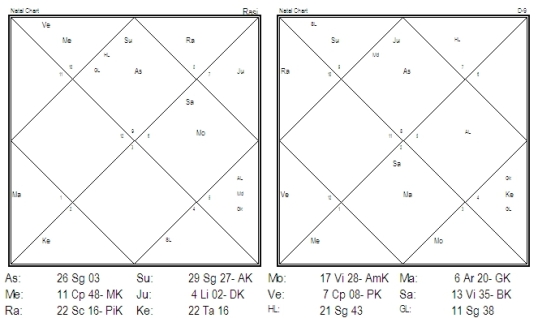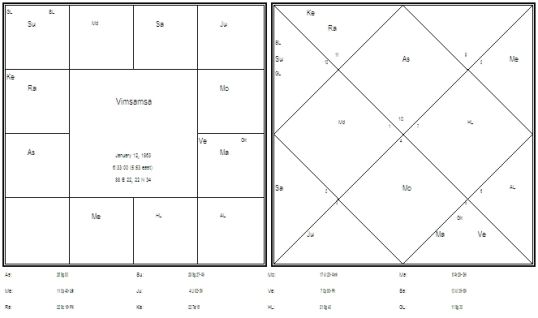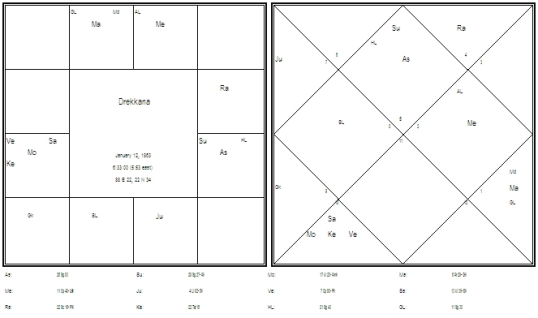Varnada Lagna
The ‘da’ in ‘Varnada’ symbolizes the three objectives of living given to the 3 types of creations by Brahma: Deva, Manusya and Raksasa; (1) Dama – That one should observe self control, unlike the devas who enjoy promiscuously; (2) Dana – That one should give, unlike manusya who are greedy; (3) Daya – That one should be merciful, unlike the raksasa who are ruthless. The Varnada Lagna is indicative of the class, through which we can fulfill, or neglect, these objectives given by Brahma.
CALCULATION OF VARNADA LAGNA
Step 1: Determine the sign of the Lagna and Hora Lagna.
Example: In the chart of Jawahar Lal Nehru, the Lagna is Cancer, an even sign and the Hora Lagna is Pisces, another even sign.
Step 2: If either the Lagna or Hora Lagna are placed in even signs, the count should be in reverse from Pisces to the Lagna or Hora Lagna. If either is in an odd sign, count from Aries in regular direction. In this count, both the starting sign occupied by the Lagna or Hora Lagna are considered.
Example continued: Lagna is an even sign Cancer. Count in anti-zodiacal direction from Pisces to Cancer. Count number = 9 signs… (A)
Hora Lagna is an even sign Pisces. Count in the anti-zodiacal direction from Pisces to Pisces. Count number = 1 signs…. (B)
Step 3: If both Lagna and Hora Lagna are in odd signs or if both are in even signs then add the count numbers obtained.
Example continued: Both Lagna and Hora Lagna are in even signs and this step is applicable. Add results of count (A) and (B). A+B = 9+1 = 10…. (C)
Step 3A: If they are different and one is in an odd sign and the other is in an even sign, then find the difference by subtracting the smaller number from the larger number. If both are equal, then the difference is zero which should translate to 12 signs.
Example continued: Both Lagna and Hora Lagna are in even signs and this step isn’t applicable. Note that only one of the steps 3 or 3A shall apply.
Step 4: If the Lagna is an even sign, count the result in reverse from Pisces. Otherwise count in the regular order from Aries.
Example continued: Lagna is an even sign therefore we are required to count the result (C) from Pisces. Counting 10 signs in the reverse from Pisces we arrive at Gemini which is Varnada Lagna of Jawahar Lal Nehru.
WHAT DOES VARNADA SHOW
From Step (1) we find that the Varnada Lagna is based on the Lagna and Hora Lagna. The Lagna indicates the native’s health, appearance, actions, intelligence and skills while the Hora Lagna shows wealth, sustenance, longevity and his value system as what he considers valuable. We may infer from the use of these that the Varnada Lagna (VL) will provide additional information about the native’s health, appearance, longevity, wealth and most important his career and social standing. It shows the native intelligence working on the value system and that karma which becomes expedient upon him to perform.
Results of Varnada Lagna
The placement of the Varnada Lagna in different houses leads causes certain karmic developments to occur in the life of the person. The result given are very general and would get modified based on
(1) Occupancy of the Varnada Lagna
(2) Placement of the Lord of Varnada Lagna which can completely change the reading.
(3) Placement of Varnada Lagna from all the three of
a) Lagna that represents the native intelligence and life.
b) Sun showing the government (king) and
c) Moon showing the society and consciousness
d) Arudha Lagna showing his status, image
e) Atmakaraka and Amatyakaraka
f) Other Varnada
HOUSES ASSOCIATED WITH VARNADA
Varnada placed in a Kendra to the Lagna will show a person who has the support of his society and family in initiating his career. If Varnada is occupied and owned by natural benefic planets then the native is strongly supported by the community and such family members indicated by the planets. If malefic planets conjoin or lord the Varnada, then strife, challenges and battles are indicated. If Moon is placed in Varnada Lagna and aspects the 9th house or lord, then career starts easily and very easily. If such a Moon is afflicted then there is considerable mental turmoil and work suffers.
Varnada Lagna placed in trines to the Lagna shows a person with good adaptability to any community, understanding and upholding the laws of that community. The Lord of Varnada, if a natural benefic and so placed shows that the native easily adapts into his career and is a strong support for his professional colleagues, but if afflicted he is tormented by his colleagues and life in the office can be very difficult.
Varnada Lagna in a dusthana (sixth, eighth or twelfth house) from Lagna makes the native shy away from the community, enjoying a life in seclusion and avoiding regular social functions and the community. The reasons for the distancing are known from the nature of the lord of the dusthana. Varnada Lagna in the twelfth house makes the native highly antisocial. This placement can, if other factors are present, show a demonical attitude towards his community, which would enable him to do unlawful acts, such as crime etc. If the lord is debilitated then the native is troubled by demonical people (showing a good soul) and if associated with Mars, will have to battle them in order to survive. If the dispositor is exalted or the lord has Nichabhanga Rajayoga then he will surely succeed in finishing the demonical opposition. In any case, if the Varnada is in the twelfth house, the native will be forced by circumstances to leave his home and fend for his fortune in another place.
Varnada in the second house makes a person an honest worker and gives a high and admirable social standing which is conducive to Rajayoga. If the Lord is also a natural benefic and is associated with another benefic planet then Rajayoga is enjoyed due to family. The nature of the Lord of the Varnada shows the source of the Rajayoga. If afflicted then the native abdicates the throne. Varnada in 3rd house makes a native free of enemies and his relationship with the community constantly improving making the native happy and content. The native has parakrama (enterprise and daring) if associated with malefic planets. Similarly, if the Varnada is in the eleventh house, the community will be source of achieving the desires of the individual.
In all cases final view can only be taken after studying the lord of Varnada, planets associated with the Varnada and its lord.
SIGNS AND VARNADA
The nature of the Rasi and Nakshatra associated with the lord of Varnada plays a deciding role in the karma necessary to achieve the mission of this life. The signs are divided into four groups based on the types of occupation. The sign occupied by the lord of Varnada shows the direction to be followed for self-actualization and such karma when performed as a karma yogi based on one’s Varnada shall lead to heaven.
| Dharma |
Tattva |
Rasi |
Graha – I |
Graha – II (guna) |
| Brahmana |
Water signs |
Cancer, Scorpio, Pisces |
Jupiter, Venus |
Jupiter, Moon |
| Ksatriya |
Fire signs |
Aries, Leo, Sagittarius |
Mars, Sun |
Mars, Sun |
| Vaisya |
Earth signs |
Taurus, Virgo, Capricorn |
Moon, Mercury |
Mercury, Venus |
| Sudra |
Air signs |
Gemini, Libra, Aquarius |
Saturn |
Saturn |
| Durajati |
|
|
Rahu, Ketu |
Rahu |
| Chandala |
Tapasvi |
|
|
Ketu |
If the lord of the Varnada is placed in a brahmana rasi then the native wishes to be a brahmana ane shall pursue education, learning, research, spirituality, occult sciences, medicine and all such professions associated with healing. The native is very creative by nature and produces fine literary works or is very skilled in healing and adept in mantra sastra etc. The exact naksatra can make considerable difference. For example if the lord of Varnada is in Cancer, brahmana karma is indicated and if this planet is also in Punarvasu nakshatra then it indicates return of the light of God or a refreshing memory and a clearer rendering of ancient knowledge. Such people can be great exponents of a well established school and can take the philosophy to its highest watermark due to a fresh application of mind on the subject. The nakshatra specifically shows mental work while the rasi or planets associated show the physical manifestation of a career. Similarly if the lord of Varnada is in a ksatriya rasi or associated with Mars or the Sun, the native pursues ksatriya dharma and has profession like king, politician, warrior, general, soldier, police etc. In this manner the other vaisya (businessman, trader) and sudra (labour, physical work, very skilled professions, artists, movie stars) should also be known from the signs and planets.
One should not be biased about profession as every profession offers its success stories and failures. To succeed it is imperative that the Varnada should associate with the signs and planets that are indicating the profession for it to come naturally. If the eleventh lord from Varnada associates, there will be great success as gains will encourage growth. This is the profession of one’s choice. If more than one planet associates then various professions or careers are indicated. Durajati indicated by the nodes refers to something coming from outside one’s native culture and shows foreign places, people and export-import. Astrologers often misinterpret dura-jati as dur-jati – the difference sounds subtle but dura means far or distant while dur means bad, base or mean and lowly.
HOUSES AND PLANETS
Houses from Varnada are examined in much the same manner as those from Arudha with the difference that primacy is given to the lord of the Varnada and that of the eleventh house from Varnada Lagna. First house shows the karma that bring name, fame and reputation; second house shows the karma that brings family and social status; third house shows the karma associated with siblings and of communications, battles and peace and messages including the upadesa from Guru; fourth house shows the karma associated with mother; fifth house shows the karma associated with children and in the manner every house shows karma association that must manifest. Those houses which have benefic planets will show a tendency for peace while malefic associations will show their guna (natures) in hard tasks requiring patience and fortitude.
Varnada is to be clearly understood as the manifestation of situations that lead to action or inaction, a decision that every person has to make, although sometimes it may be almost enforcing, yet it is a decision that every person has to make, although sometimes it may be almost enforcing, yet it is a decision made within the boundary of options. Varnada shows the most likely decision by the placement of graha in houses from the Varnada Lagna (native himself) and others based on other varnada. Varnada are always in pairs showing that no decision is isolated.
The various houses from the Varnada will show the support the native gets from relatives and society – third and eleventh shows younger and elder co-born respectively; fourth and ninth shows mother and father respectively; fifth shows children and paternal grandfather; sixth shows maternal relatives; seventh spouse and maternal grandmother; twelfth maternal grandfather and paternal grandmother. In addition the houses from the Varnada Lagna will show the gains and obstructions to the objectives of the native.
- Saturn, Rahu and Ketu show hard work, association with mysterious people and lowlifes respectively. These three cause good results when posited in 8th, 9th or 12th houses from the Varnada Lagna. If placed in 3rd from Varnada Lagna, the native has no enemies in financial matters. Also as per Jaimini Sutras, the native will have emancipation.
- Any planets in the stronger of 5th and 11th houses from the Varnada Lagna cause gains and show the source of the gains. The lords of these houses should also be assessed.
- Benefics in the 7th house from the Varnada Lagna will make the native very easy going in the community and even childish. Malefic planets will cause the opposite results.
- Benefics in the 9th house from the Varnada Lagna will protect the native in the community, while malefics so placed may afflict the longevity.
- Varnada Lagna in the second house or its lord therein shows many relationships with beautiful women.
- Varnada Lagna in the third house generally brings contentment after receiving Guru Upadesa and if the same is having good associations.
- The six planets from Sun to Venus associating with the Varnada show karma that is far reaching and the native is well placed.
- The givers of tamas, especially Saturn and nodes, associating can bring deep sorrow and discontentment, especially if they are in odd signs and aspect or conjoin the Varnada indicating fruit less work, cheating or misdirection and disillusionment respectively. If these planets are in the eighth or twelfth then conversely, they bring success and joys when one renounces the things and people indicated by the bhava and Arudha Padas associated with these houses. In the ninth they give power to overcome the evil of tamas provided they are not themselves weak and debilitated, else the converse occurs and the native takes joy in bad things and hurting others.
- Benefics planets placed in or aspecting the third house from Varnada Lagna always keep him laughing and playfully childish even in the midst of difficulties. Such people are very high spirited.




